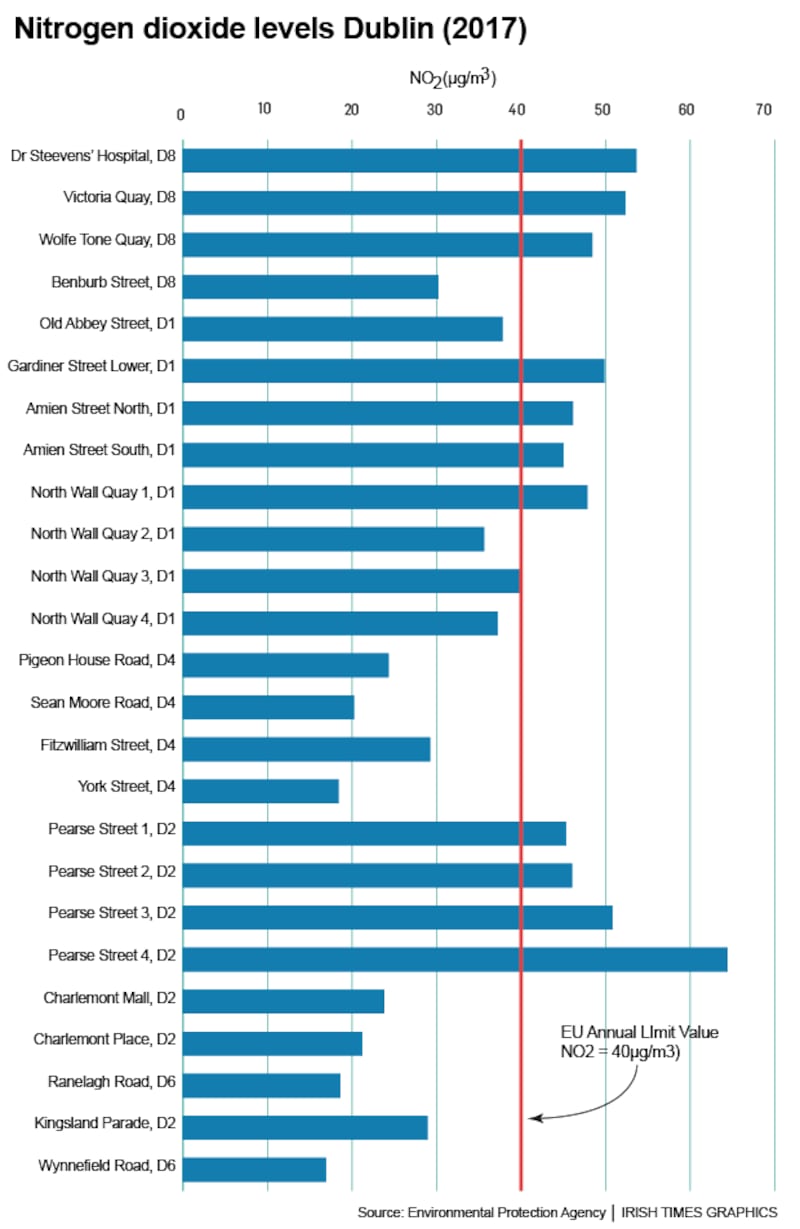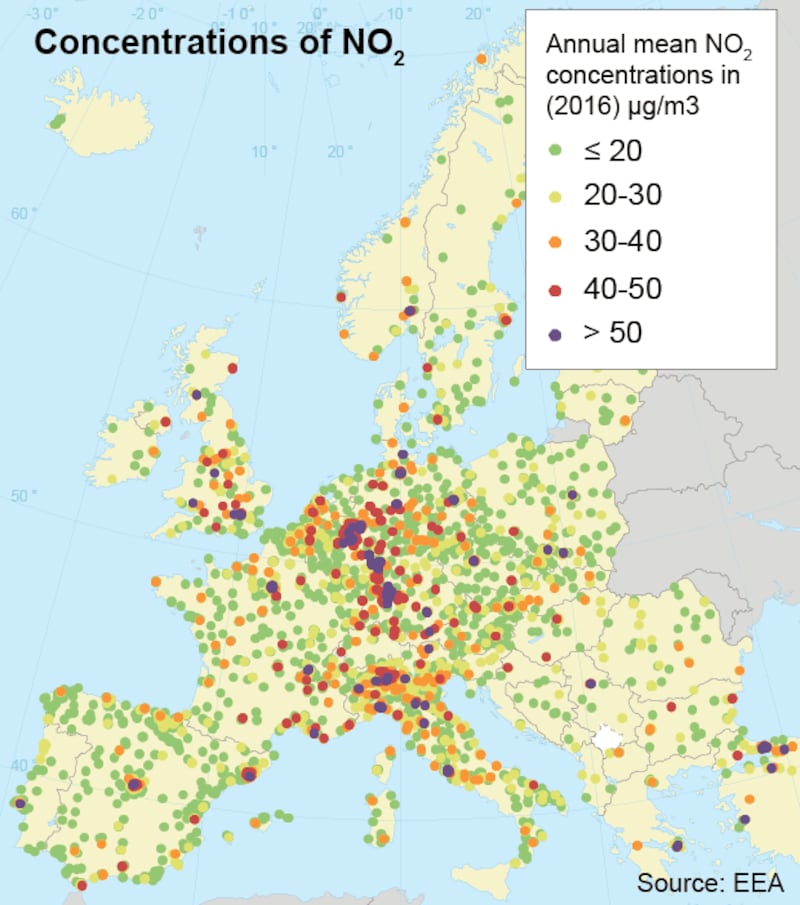Many areas of Dublin are experiencing worsening air pollution caused by nitrogen dioxide (NO2) with indications that frequent breaches of EU limits are occurring due to large volumes of traffic, according to an EPA warning.
High levels of nitrogen oxides cause acid rain and ozone but are of most concern due to their health impact, notably their contribution to respiratory illness and asthma – with children and older people most vulnerable.
In a report, the EPA identified the worst areas in the capital as along the quays; at the entrance to and exit from the Dublin Tunnel, along the M50, on Pearse Street and in the vicinity of Heuston Station.


The EPA warning is largely based on preliminary results from a network of new surveillance stations in the city. Breaches are usually calculated on a yearly basis.
With every indication exceedances are likely once results are completed by the end of 2019, the EPA decided to alert local authorities in the capital early on the implications.
If further studies and test results confirm NO2 levels have been exceeded, local authorities in Dublin and its suburbs will be required to prepare air quality action plans and intervene to reduce emissions, the EPA confirmed.
They will then have to consider a range of possible measures to reduce emissions, including congestion charges; creation of “low emission zones”, increased use of low emission public transport and measures to encourage people out of polluting vehicles. This could be by providing “park and ride” facilities; cycling infrastructure and extra electric vehicle charging points.
This course has been forced on many EU cities due to rising air pollution – notably in London and Paris. In some cases, cars have to be registered and only those with lower emissions, such as newer models on the road since 2015, are permitted in city centres.

The EPA is already working with local authorities and the Government on what may be needed including modelling options to see what specific actions might achieve in reducing NO2, said EPA programme manager Dr Ciara McMahon.
“This report outlines the findings of two recent studies which suggest levels of nitrogen dioxide in certain parts of Dublin are exceeding the EU limit value. Given the known health impacts on people’s respiratory systems, this is a cause of concern,” she added.
Previous EPA reports flagged NO2 as being “potentially problematic”, with levels approaching the EU limit value in urban areas. “This report presents new evidence from dispersion modelling and monitoring using NO2 measurement tubes which indicate that NO2 may exceed the annual EU limit value.”
New equipment to assess air quality is being installed across the country including in Dublin. Geared to provide increased access to air-quality information, the programme enabled the EPA to identify suitable sites for additional air-monitoring stations.
As a result, a new monitoring station was set up at St John’s Road West, near Heuston Station, while another will be opening on Pearse Street shortly.
“The climate action measures recently put forward by Government for the transport sector in Dublin can also act to reduce harmful, health-impacting pollutants such as nitrogen dioxide,” Dr McMahon added. This report is a further call for co-ordinated action to tackle transport emissions in Dublin.”
What is nitrogen dioxide?
Emissions from traffic are the main source of nitrogen oxides (including nitrogen dioxide) in Ireland along with electricity-generating stations and industry. Levels have been increasing due to growth in traffic on the roads. It impacts visually as it gives rise to a brown haze. Oxides of nitrogen contribute to the formation of acid rain and of ozone.
What are the health impacts?
NO2 can affect the throat and lung, causing emphysema and cellular damage. Exposure to high levels over short periods can give rise to acute health effects: aggravating respiratory diseases, particularly asthma. Longer exposure to elevated concentrations of NO2 may contribute to the development of asthma and potentially increase susceptibility to respiratory infections. People with asthma, children and older people are at greater risk.
Why do NO2 levels vary dramatically?
Levels of nitrogen dioxide in cities and towns can vary dramatically over a short distance (a few metres), with the highest concentrations within 10m of the road side. Levels decrease significantly the further away you are from roads. Levels also vary depending on factors such as: how much traffic there is; ages of vehicles, types of vehicles (diesel engines are associated with higher levels than petrol engines), vehicle speed, the width of streets and their buildings, and weather conditions.
What are the test locations in Dublin?
Locations where air quality is monitored (the vast majority of which is on an hourly basis) are: Ballyfermot; Blanchardstown, Clonskeagh, Davitt Road, Dún Laoghaire, Finglas, Marino, Phoenix Park, Rathmines, Ringsend, Rosemount, St Anne's Park, St John's Road West, Swords, Tallaght and Winetavern Street.
What is the EU limit for NO2?
EU directives set two limits for the protection of human health: A limit on the annual average is set at 40 micrograms per cubic metre to protect against the health effects from long-term exposure. An hourly mean value of 200 micrograms per cubic metre is also set which is considered breached if more than 18 exceedances occur in a year. This is to protect against “acute health effects”.










